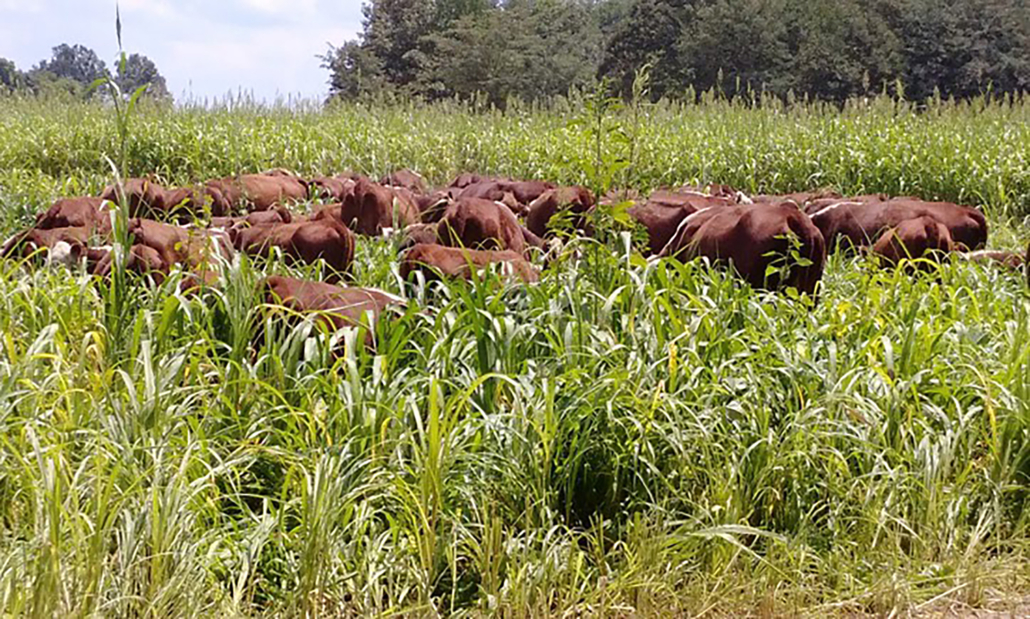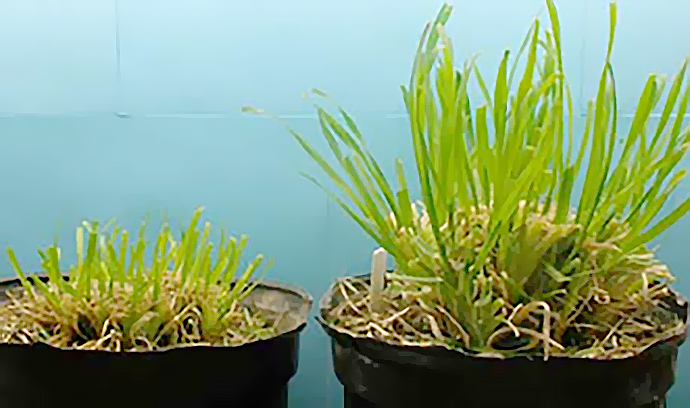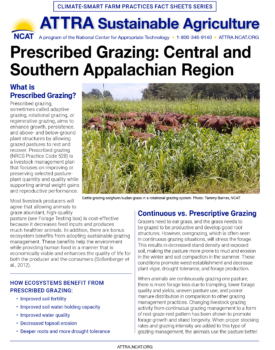Prescribed Grazing: Central and Southern Appalachian Region

Cattle grazing sorghum/sudan grass in a rotational grazing system. Photo: Tammy Barnes, NCAT
CLIMATE-SMART FARM PRACTICES FACT SHEET SERIES
By Tammy Barnes, NCAT Agriculture Specialist
What is Prescribed Grazing?
Prescribed grazing, sometimes called adaptive grazing, rotational grazing, or regenerative grazing, aims to enhance growth, persistence, and above- and below-ground plant structures by allowing grazed pastures to rest and recover. Prescribed grazing (NRCS Practice Code 528) is a livestock management plan that focuses on improving or preserving selected pasture-plant quantity and quality while supporting animal weight gains and reproductive performance.
How ecosystems benefit from prescribed grazing:
- Improved soil fertility
- Improved soil water-holding capacity
- Improved water quality
- Decreased topsoil erosion
- Deeper roots and more drought tolerance
Most livestock producers will agree that allowing animals to graze abundant, high-quality pasture (see Forage Testing box below) is cost-effective because it decreases feed inputs and produces much healthier animals. In addition, there are bonus ecosystem benefits from adopting sustainable grazing management. These benefits help the environment while providing human food in a manner that is economically viable and enhances the quality of life for both the producer and the consumers (Sollenberger et al., 2012).
Forage Testing: What makes for a quality forage?
- High in crude protein for species:
- Alfalfa around 24%
- Grass around 15%
- Low in neutral detergent fiber (<50%)
- High Total Digestible Nutrients (TDN) percentage (the closer to 100%, the better)
- Not overly mature or stemmy
- Palatable and not toxic
Continuous vs. Prescriptive Grazing
Grazers need to eat grass, and the grass needs to be grazed to be productive and develop good root structures. However, overgrazing, which is often seen in continuous grazing situations, will stress the forage. This results in decreased stand density and exposed soil, making the pasture more prone to mud and erosion in the winter and soil compaction in the summer. These conditions promote weed establishment and decrease plant vigor, drought tolerance, and forage production.
When animals are continuously grazing one pasture, there is more forage loss due to trampling, lower forage quality and yields, uneven pasture use, and poorer manure distribution in comparison to other grazing management practices. Changing livestock grazing activity from continuous grazing management to a form of rest-graze-rest pattern has been shown to promote forage growth and stand longevity. When proper stocking rates and grazing intensity are added to this type of grazing management, the animals use the pasture better. In other words, the livestock eat what’s before them instead of only the choice plants. The optimum number of animals will make efficient use of the available forage without waste but still leave enough foliage to allow for complete, timely plant recovery.
What’s the Best Grazing Strategy?
A planned or prescribed grazing system allows the animals to graze when the plants are ready, as determined by plant height and leaf stage. In general, most pasture plants in this region are ready to be grazed between six and 10 inches and should not be grazed lower than three to four inches. Then, the pasture is rested until the plants have recovered from that grazing event. The length of the rest phase is dependent on the time of year, plant species, stocking rate and grazing intensity, rainfall, and soil fertility.
Planned grazing looks different from farm to farm and depends on the kind of livestock, their nutrient requirements, water sources and their locations, plant species (forbs, warm- or cool-season forage), slope, labor and time for rotation, and the landowner’s pastureland improvement aims and production goals. For example, one method simply rotates the herd between two or more pastures, paying attention to the plant growth to decide when to move the stock. A more complex system may feature many paddocks and more frequent moves, concentrating the livestock in a smaller area to encourage even grazing and manure distribution. Some producers move livestock every day and find that this improves pastures rapidly. Experience shows how much space to allow per paddock to get the desired grazing height and good animal performance. Whatever strategy works for the producer, their livestock, and the land is the best system.
Tips for a successful rotational (prescriptive) grazing plan:
- Change mindset from being a livestock producer to a plant/pasture producer.
- Focus on soil fertility:
- Take soil samples every two or three years. Lime and fertilize according to the State’s recommendations. County Extension agents and local Soil and Water Conservation Districts can provide these recommendations.
- Consider bale feeding or unrolling hay when fed to distribute manure nutrients. If manure is stockpiled in a feedlot, consider land application in the spring.
- Provide access to an adequate water supply in each paddock or pasture. Permanent or temporary watering systems can be used. Topography and number of livestock should be considered.
- Install a permanent fence around the property’s perimeter. Electric or temporary fencing can be used on the interior. Temporary internal fences during the early years make it possible to test the paddock arrangement for efficiency and convenience. Technical support is available through NRCS and NCAT.
- Maintain proper stop/start grazing heights. The rule of thumb for most grass species is to start grazing at six to 10 inches and stop grazing at three to four inches. For some species, taller stop heights are needed: approximately five inches for switchgrass, Indiangrass, red clover, and big bluestem. The key is to remove livestock while there are enough leaves to allow fast regrowth and recovery, increasing forage production and stand longevity and decreasing the opportunity for weed establishment (See photo below).
- Observe and be flexible in responding to livestock and pasture needs throughout the season and notice the results of decisions. Prescriptive grazing depends on the manager learning and adapting; there is no “formula.”
- Keep learning.
- Plan for various weather conditions:
- Provide supplemental hay and/or destock during drought and during winter.
- Remove animals to a sacrifice lot or heavy-use area during muddy times.
- Unroll hay on the pasture if the ground is dry or frozen to distribute nutrients and build soil.
- Avoid feeding hay in the same spots long-term to avoid pugging

Six days post-grazing regrowth. Plant on the left has been clipped to simulate continuous grazing and plant on right simulates rotational grazing. Source: Rotational Grazing. University of Kentucky Extension Publication ID143 (Smith et al., 2011).
Conclusion
Prescriptive, rotational, adaptive, and regenerative grazing are all methods of controlling where the livestock are grazing, so that plants have the maximum chance to thrive and carry on photosynthesis, thus improving soil health and water-holding capacity, as well as water quality. These thriving plants produce more and support healthy livestock growth and reproduction and therefore improve profitability and satisfaction for the livestock producer. To learn more about this practice, consult your local NRCS agent.
References
Smith, R., G. Lacefield, R. Burris, D. Ditsch, B. Coleman, J. Lehmkuhler, and J. Henning. 2011. Rotational Grazing. University of Kentucky Extension Publication ID143.
Sollenberger, Lynn E., Carmen T. Agouridis, Eric S. Vanzant, Alan J. Franzluebbers, and Lloyd B. Owens. 2012. Prescribed Grazing on Pasturelands. Biosystems and Agricultural Engineering Faculty Publications.
Further Resources
ATTRA Grazing Planning Manual and Workbook
Building Healthy Pasture Soils
Pasture, Rangeland and Adaptive Grazing
Prescribed Grazing: Central and Southern Appalachian Region
By Tammy Barnes, Sustainable Agriculture Specialist
Published February 2024
©NCAT
IP634
This publication is produced by the National Center for Appropriate Technology through the ATTRA Sustainable Agriculture program, under a cooperative agreement with USDA Rural Development. This publication was also made possible in part by funding from the Partnership for Climate-Smart Commodities Grant-Building Soils, Building Equity, as administered by the USDA, grant # NR233A750004G024. ATTRA.NCAT.ORG


